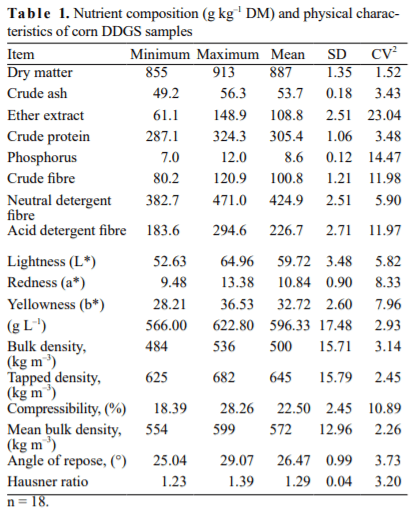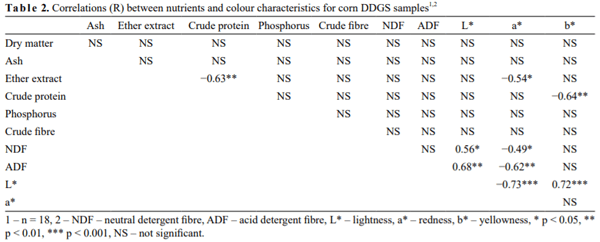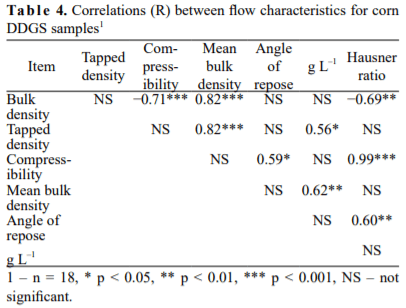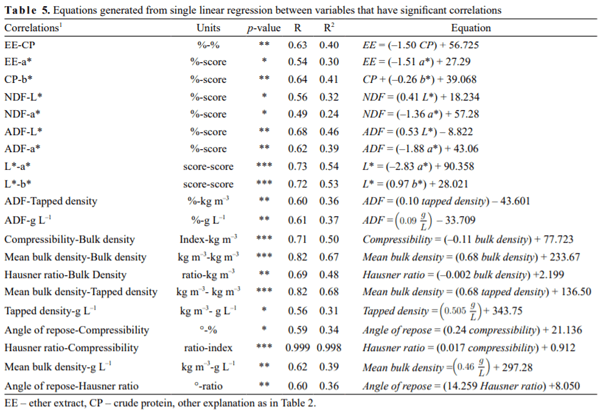Impact of chemical and physical properties on flowability characteristics of corn distillers dried grains with solubles
Author details:
The influence of the physical and chemical composition of corn distillers dried grains with solubles on its flowability was evaluated in the current study. The samples were evaluated for angle of repose, compressibility, Hausner ratio, tapped density, bulk density, mean bulk density, colour and nutrient content. PROC CORR and REG procedures were used to determine correlations. The ether extract was negatively correlated with crude protein and redness (a*), while crude protein was negatively correlated with yellowness (b*). Acid detergent fibre and neutral detergent fibre were negatively correlated with a* and positively correlated with lightness (L*), respectively. Compressibility showed a negative correlation with bulk density. Bulk density, tapped density and mean bulk density did not impact the angle of repose. The angle of repose was positively correlated with the compressibility and Hausner ratio. Apart from the correlation between acid detergent fibre and tapped density, the angle of repose and other physical parameters were not affected by the nutrient composition of the distillers dried grains with solubles samples. In conclusion, the results of this study indicate that nutrient composition has little influence over the flowability of distillers dried grains with solubles but compressibility and the Hausner ratio can be used to predict the potential flow characteristics of corn distillers dried grains with solubles.
Keywords: angle of repose, bulk density, compressibility, distillers dried grains with solubles, flowability.






Adeola O. and Zhai H., 2012. Metabolizable energy value of dried corn distillers grains and corn distillers grains with solubles for 6-week-old broiler chickens. Poult. Sci., 91, 712-718, https://doi.org/10.3382/ps.2011-01889
Akayezu J.M., Linn J.G., Harty S.R., and Cassady J.M., 1998. Use of distillers grains and co-products examined. Feed-stuffs., 70, 11-13.
Aliyu B., Agnew B., and Douglas S., 2010. Croton megalocarpus (Musine) seeds as a potential source of bio-diesel. Biomass Bioenerg., 34, 1495-1499, https://doi.org/10.1016/j.biombioe. 2010.04.026
Amin M.N., Hossain M.A., and Roy K.C., 2004. Effects of moisture content on some physical properties of lentil grains. J. Food Eng., 65, 83-87.
AOAC, 2006. Official Methods of Analysis of AOAC Interna-tional. 18th ed., AOAC Int., Gaithersburg, MD.
Bandegan A., Guenter W., Hoehler D., Crow G.H., and Nya-choti C.M., 2009. Standardized ileal amino acid digestibility in wheat distillers dried grains with solubles for broilers. Poult. Sci., 88, 2592-2599, https://doi.org/10. 3382/ps.2009-00309
Baryeh E.A., 2002. Physical properties of millet. J. Food Eng., 51, 39-46, https://doi.org/10.1016/S0260-8774(01)00035-8
Belyea R.L., Rausch K.D., and Tumbleson M.E., 2004. Compo-sition of corn and distillers dried grains with solubles from dry grind ethanol processing. Bioresour. Technol., 94, 293-298, https://doi.org/10.1016/j.biortech.2004.01.001
Belyea R.L., Rausch K.D., Clevenger T.E., Singh V., Johnston D.B., and Tumbleson M.E., 2010. Sources of variation in composition of DDGS. Anim. Feed Sci. Technol., 159, 122-130, https://doi.org/10.1016/j.anifeedsci.2010.06.005
Bhadra R., Rosentrater K.A., and Muthukumarappan K., 2008. Surface characteristics and flowability of distillers dried grains with solubles. ASABE meeting presentation, https://doi.org/10.13031/2013.25024 · Source: OAI
Bhadra R., Muthukumarappan K., and Rosentrater K.A., 2009. Flowability properties of commercial distillers dried grains with solubles (DDGS). Cereal Chem., 86, 170-180, https://doi.org/10.1094/CCHEM-86-2-0170
Bhadra R., Muthukumarappan K., and Rosentrater K.A., 2012. Effects of CDS and drying temperature levels on the flowability of DDGS. Drying Technol., 20, 542-558, htt-ps://doi.org/10.1080/07373937.2011.649510
Carr R.L., 1965. Evaluating flow properties of solids. Chem. Eng., 72, 163-168.
Crawford N.C., Nagle N., Sievers D.A., and Stickel J.J., 2016. The effects of physical and chemical preprocessing on the flowability of corn stover. Biomass Bioenerg., 85, 126-134, https://doi.org/10.1016/j.biombioe.2015.12.015
De Matteis M.C., Yu T.E., Boyer C.N., and DeLong K.L., 2019. Analyzing determinants of US distillers dried grains with solubles exports. Agribusiness., 35, 168-181, https://doi.org/ 10.1002/agr.21575
Ganesan V., Rosentrater K.A., and Muthukumarappan K., 2005. Effect of moisture content and soluble levels on the physical and chemical properties of DDGS. ASAE Paper No.056110,ASAE,St.Joseph,MI.doi:10.13031/2013.20125
Ganesan V., Rosentrater K.A., and Muthukumarappan K., 2008. Flowability and handling characteristics of bulk sol-ids and powders: A review with implications for DDGS. Biosyst Eng., 101, 425-435, https://doi.org/10.1016/j.bio-systemseng.2008.09.008
Guney A.C., Shim M.Y., Batal A.B., Dale N.M., and Pesti G.M., 2013. Effect of feeding low oil distillers dried grains with solubles on the performance of broilers. Poult. Sci., 92, 2070-2076, https://doi.org/10.3382/ps.2012-02699
Hossain M.A., Khaleque M.A., and Hassan M.S., 1998. Physi-cal characteristics of groundnut kernels at various moisture contents. Legume Res., 21, 79-84.
Joshi D.C., Das S.K., and Mukherjee R.K., 1993. Physical properties of pumpkin seed. J. Agric. Eng. Res., 54, 219-229, https://doi.org/10.1006/jaer.1993.1016
Juliano P. and Barbosa-Canovas G.V., 2010. Food powders flowability characterization: theory, methods, and applica-tions. Annu. Rev. Food Sci. T., 1(1), 211e239, https://doi. org/10.1146/annurev.food.102308.124155.
Keierleber C. and Rosentrater K.A., 2010. Granular packing influences bulk density of DDGS. Cereal Chem., 87, 586-596, https://doi.org/10.1094/CCHEM-04-10-0055
Kingsly A.R.P. and Ileleji K.E., 2009. Sorption isotherm of corn distillers dried grains with solubles and its prediction using chemical composition. Food Chem., 116, 939-946, https:// doi.org/10.1016/j.foodchem.2009.03.050
Kingsly A.R.P., Ileleji K.E., Clementson C.L., Garcia A., Maier D.E., Stroshine R.L., and Radcliff S., 2010. The effect of process variables during drying on the physical and chemical characteristics of corn dried distillers grains with solubles (DDGS)- plant scale experiments. Bioresour. Technol., 101, 193-199, https://doi.org/10.1016/j.biortech. 2009.07.070
Ortín W.G.N. and Peiqiang Y., 2009. Nutrient variation and availability of wheat DDGS, corn DDGS and blend DDGS from bioethanol plants. J. Sci. Food Agr., 89(10), 1754e61, https://doi.org/10.1002/jsfa.3652
Pekel A.Y., Çakir E.O., Polat M., Çakir K., Inan G., and Kocabagli N., 2013. Correlations between chemical assays and near-infrared reflectance spectroscopy for nutrient components and correlations between nutrients and color scores of distillers dried grains with solubles. J. Appl. Poult. Res., 22, 814-824, https://doi.org/10.3382/japr.2013-00728
Pinotti L. and Dell’Orto V., 2011. Feed safety in the feed supply chain. Biotechnol. Agron. Soc. Environ., 15, 9-14.
Rosentrater K.A., 2006. Some physical properties of distillers dried grains with solubles (DDGS). Appl. Eng. Agri., 22, 589-595. http://dx.doi.org/10.13031/2013.21212
Samson R. and Mehdi B., 1998. Strategies to Reduce the Ash Content in Perennial Grasses; Resource Efficient Agricul-tural Production-Canada: Sainte-Anne-de-Bellevue, QC, Canada.
Saragoni P., Aguilera J.M., and Bouchon P., 2007. Changes in particles of coffee powder and extensions to cake. Food Chem., 104, 122-126, https://doi.org/10.1016/j.foodchem. 2006.11.029
SAS Institute, 2006. “SAS/STAT User’s Guide. Release 9.1”, Cary, NC, USA, SAS Inst Inc.
Shurson J., Spiehs M., Whitney M., Baidoo S., Johnston L., Shanks B., and Wulf D., 2001. The value of distillers dried grains with solubles in swine diets. In:Mn. Nutr. Conf. Mn. Corn Growers Assoc. Tech. Sympos., Bloomington, MN.
Spiehs M.J., Whitney M.H., and Shurson G.C., 2002. Nutrient database for distillers’ dried grains with solubles produced from new ethanol plants in Minnesota and South Dakota. J. Anim. Sci., 80, 2639-2645, https://doi.org/10.1093/ansci/ 80.10.2639
Swiatkiewicz S. and Koreleski J., 2008. The use of distillers dried grains with solubles (DDGS) in poultry nutrition. World’s Poult. Sci. J., 64, 257-265, https://doi.org/10.1017/ S0043933908000044
US Grains Council, 2019. Buying and selling. DDGS. Production and Exports. https://grains.org/buying-selling/ddgs/
Van Soest P.J., Robertson J.B., and Lewis B.A., 1991. Methods for dietary fiber, neutral detergent fiber, and nonstarch poly-saccharides in relation to animal nutrition. J. Dairy Sci., 74, 3583-3597, https://doi.org/10.3168/jds.S0022-0302(91)78551-2
Wang H.Y., Bai S.P., Ding X.M., Wang J.P., Zeng Q.F., Su Z.W., Xuan Y., and Zhang K.Y., 2018. Nitrogen-corrected appar-ent metabolizable energy value of corn distillers dried grains with solubles for laying hens. Anim. Feed. Sci. Tech., 238, 66-72, https://doi.org/10.1016/j.anifeedsci.2018.02.002
Zou Y. and Brusewitz G.H., 2002. Flowability of uncompacted marigold powder as affected by moisture content. J. Food Eng., 55, 165-171, https://doi.org/10.1016/S0260-8774(02) 00060-2







.jpg&w=3840&q=75)